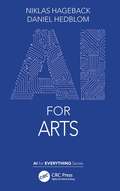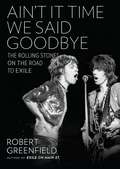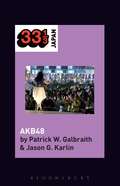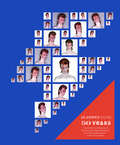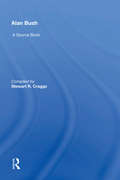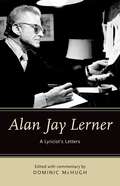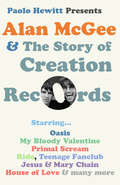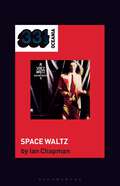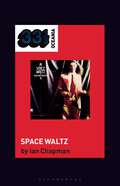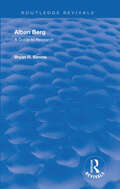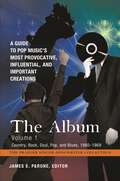- Table View
- List View
AI for Arts (AI for Everything)
by Niklas Hageback Daniel HedblomAI for Arts is a book for anyone fascinated by the man–machine connection, an unstoppable evolution that is intertwining us with technology in an ever-greater degree, and where there is an increasing concern that it will be technology that comes out on top. Thus, presented here through perhaps its most esoteric form, namely art, this unfolding conundrum is brought to its apex. What is left of us humans if artificial intelligence also surpasses us when it comes to art? The articulation of an artificial intelligence art manifesto is long overdue, so hopefully this book can fill a gap that will have repercussions not only for aesthetic and philosophical considerations but possibly more so for the development of artificial intelligence.
Ain't It Time We Said Goodbye: The Rolling Stones on the Road to Exile
by Robert GreenfieldFor ten days in March 1971, the Rolling Stones traveled by train and bus to play two shows a night in many of the small theaters and town halls where their careers began. No backstage passes. No security. No sound checks or rehearsals. And only one journalist allowed. That journalist now delivers a full-length account of this landmark event, which marked the end of the first chapter of the Stones' extraordinary career.Ain't It Time We Said Goodbye is also the story of two artists on the precipice of mega stardom, power, and destruction. For Mick and Keith, and all those who traveled with them, the farewell tour of England was the end of the innocence.Based on Robert Greenfield's first-hand account and new interviews with many of the key players, this is a vibrant, thrilling look at the way it once was for the Rolling Stones and their fans-and the way it would never be again.
Ain't It Time We Said Goodbye: The Rolling Stones on the Road to Exile
by Robert GreenfieldFor ten days in March 1971, the Rolling Stones traveled by train and bus to play two shows a night in many of the small theaters and town halls where their careers began. No backstage passes. No security. No sound checks or rehearsals. And only one journalist allowed. That journalist now delivers a full-length account of this landmark event, which marked the end of the first chapter of the Stones' extraordinary career.Ain't It Time We Said Goodbye is also the story of two artists on the precipice of mega stardom, power, and destruction. For Mick and Keith, and all those who traveled with them, the farewell tour of England was the end of the innocence.Based on Robert Greenfield's first-hand account and new interviews with many of the key players, this is a vibrant, thrilling look at the way it once was for the Rolling Stones and their fans-and the way it would never be again.
AKB48 (33 1/3 Japan)
by Patrick W. Galbraith Jason G. KarlinSince its formation as a girl group in 2005, AKB48 has become a phenomenal success and institution in Japan. Having originally recruited fans with photocopied fliers and daily performances in the Akihabara area of Tokyo, AKB48 now saturates Japan. Its members--nearly 800 of them, including five sister groups and four so-called "rival groups" across Japan, as well as six sister groups in other Asian cities--appear in print, broadcast, online, and social media; in advertisements and on products; at home and on the train; on- and off-screen.AKB48's multi-platform omnipresence is characteristic of "idols," whose intimate relationship to fans and appeals to them for support have made the group dominant on the Oricon Yearly Singles Chart in the 2010s; they hold several records, including most consecutive million-selling singles sold in Japan. A unique business model relentlessly monetizes fans' affections through meet-and-greet events and elections, which maximize CD sales, and their saturated presence in the media. At a time when affect is more important than ever in economic, political, and social theory, this book explores the intersection of idols and affect in contemporary Japan and beyond.
AKB48 (33 1/3 Japan)
by Patrick W. Galbraith Jason G. KarlinSince its formation as a girl group in 2005, AKB48 has become a phenomenal success and institution in Japan. Having originally recruited fans with photocopied fliers and daily performances in the Akihabara area of Tokyo, AKB48 now saturates Japan. Its members--nearly 800 of them, including five sister groups and four so-called "rival groups" across Japan, as well as six sister groups in other Asian cities--appear in print, broadcast, online, and social media; in advertisements and on products; at home and on the train; on- and off-screen.AKB48's multi-platform omnipresence is characteristic of "idols," whose intimate relationship to fans and appeals to them for support have made the group dominant on the Oricon Yearly Singles Chart in the 2010s; they hold several records, including most consecutive million-selling singles sold in Japan. A unique business model relentlessly monetizes fans' affections through meet-and-greet events and elections, which maximize CD sales, and their saturated presence in the media. At a time when affect is more important than ever in economic, political, and social theory, this book explores the intersection of idols and affect in contemporary Japan and beyond.
Aladdin Sane 50: The definitive celebration of Bowie's iconic album and music's most famous photograph – with unseen images
by Chris DuffyOn the fiftieth anniversary of David Bowie's magical album, Aladdin Sane 50 is the ultimate celebration of a musical masterpiece – and the most famous photograph in pop history.This landmark book contains hundreds of photographs, including dozens of David from the Aladdin Sane session that have never been seen until now, fifty years since they were taken.Aladdin Sane 50 also features essays by renowned experts and authors Paul Morley, Charles Shaar Murray, Nicholas Pegg, Kevin Cann, Jérôme Soligny and Geoffrey Marsh on Bowie's remarkable album and the story behind the famous cover.In a breathtaking package designed by long-time Bowie collaborators Barnbrook creative studio, Aladdin Sane 50 pays tribute to a seminal album and an iconic image, one that will live forever more in rock 'n' roll history.
Alan Bush: A Source Book
by Stewart CraggsBorn in 1900, Alan Bush, the English composer, conductor and pianist, studied with Corder and Matthay, and privately with John Ireland. He was appointed professor of harmony and composition at the Royal Academy of Music in 1925, a post he held until 1978. In 1929-31, he continued to study at Berlin University and had piano lessons with Moiseiwitsch and Schnabel. The present Source Book documents his works (many of which reflect his Communist sympathies) and the many arrangements of music by other composers. A wealth of detail is provided, including printed scores, CD recordings, bibliographical material and manuscript scores and their locations, the majority of which have been deposited recently in the British Library by the Bush family. A chronology of the composer's life draws on many sources including letters and scrapbooks.
Alan Bush: A Source Book
by Stewart R. CraggsBorn in 1900, Alan Bush, the English composer, conductor and pianist, studied with Corder and Matthay, and privately with John Ireland. He was appointed professor of harmony and composition at the Royal Academy of Music in 1925, a post he held until 1978. In 1929-31, he continued to study at Berlin University and had piano lessons with Moiseiwitsch and Schnabel. The present Source Book documents his works (many of which reflect his Communist sympathies) and the many arrangements of music by other composers. A wealth of detail is provided, including printed scores, CD recordings, bibliographical material and manuscript scores and their locations, the majority of which have been deposited recently in the British Library by the Bush family. A chronology of the composer's life draws on many sources including letters and scrapbooks.
Alan Jay Lerner: A Lyricist's Letters
by Dominic McHughThe man behind "I Could Have Danced all Night" and "Almost Like Being in Love", lyricist Alan Jay Lerner (1918-1986) is widely regarded as one of the most important figures of the American musical stage. In penning the lyrics to some of the most well-known and beloved Broadway shows, including Brigadoon, Paint Your Wagon, My Fair Lady, and Camelot, Lerner worked and corresponded with some of the greatest luminaries of popular entertainment over a career which spanned four decades, from performers like Rex Harrison and Julie Andrews to composers like André Previn, Leonard Bernstein, Charles Strouse, Andrew Lloyd Webber, and especially Frederick Loewe. In this rich collection of correspondence, most of it published for the first time, author Dominic McHugh sheds new light on Lerner's working relationships with these legendary figures. McHugh's extensive commentary reveals Lerner's turbulent partnerships with Loewe and Lane, his affection for Harrison, and his reverence for Burton. Particular emphasis is placed on Lerner's aborted projects with composers like Richard Rodgers and Arthur Schwartz. Especially valuable is the correspondence from his final years, in which he worked on a movie version of The Merry Widow, a BBC TV series about musicals, and a musical version of My Man Godfrey, none of which came to fruition. The collection ends with a poignant final exchange between Lerner and Andrew Lloyd Webber, with whom he was to have written The Phantom of the Opera. Overall, this important and lively book reveals the highs and lows of the career of one of America's wittiest and most romantic lyricists.
Alan Jay Lerner: A Lyricist's Letters
by Dominic MchughThe man behind "I Could Have Danced all Night" and "Almost Like Being in Love", lyricist Alan Jay Lerner (1918-1986) is widely regarded as one of the most important figures of the American musical stage. In penning the lyrics to some of the most well-known and beloved Broadway shows, including Brigadoon, Paint Your Wagon, My Fair Lady, and Camelot, Lerner worked and corresponded with some of the greatest luminaries of popular entertainment over a career which spanned four decades, from performers like Rex Harrison and Julie Andrews to composers like André Previn, Leonard Bernstein, Charles Strouse, Andrew Lloyd Webber, and especially Frederick Loewe. In this rich collection of correspondence, most of it published for the first time, author Dominic McHugh sheds new light on Lerner's working relationships with these legendary figures. McHugh's extensive commentary reveals Lerner's turbulent partnerships with Loewe and Lane, his affection for Harrison, and his reverence for Burton. Particular emphasis is placed on Lerner's aborted projects with composers like Richard Rodgers and Arthur Schwartz. Especially valuable is the correspondence from his final years, in which he worked on a movie version of The Merry Widow, a BBC TV series about musicals, and a musical version of My Man Godfrey, none of which came to fruition. The collection ends with a poignant final exchange between Lerner and Andrew Lloyd Webber, with whom he was to have written The Phantom of the Opera. Overall, this important and lively book reveals the highs and lows of the career of one of America's wittiest and most romantic lyricists.
Alan McGee and The Story of Creation Records: This Ecstasy Romance Cannot Last
by Paolo HewittAlan McGee's legendary Creation record label brought us Oasis, Primal Scream, Jesus and Mary Chain, My Bloody Valentine, House of Love, Teenage Fanclub and many of the other most exciting and innovative bands of the eighties and nineties. But it also eventually brought McGee to a breakdown so complete that it took him two years to recover. Alan McGee started Creation in 1983 with a loan of ?1,000. McGee considered himself a loser when it came to school, girls and good looks, but he had two things on his side: punk attitude and an uncanny ability to detect musical genius. Within two years, McGee had launched The Jesus and Mary Chain, sold hundreds of thousands of records and created an indie empire that was a byword for headstrong independence. By 1992, McGee was a millionaire, living an unrestrained hedonistic lifestyle. In 1993 he discovered Oasis, and within a year of partying with the band he entered rehab following a near-death experience in Los Angeles. Paolo Hewitt, the bestselling biographer of Oasis, received full co-operation from Alan McGee and all the key Creation personnel for this candid, often funny, sometimes shocking oral history. It captures in vivid colour one of the richest chapters in British rock history. Creation and its roster are going to live forever.
Alastair Riddell’s Space Waltz (33 1/3 Oceania)
by Ian ChapmanAlastair Riddell's band Space Waltz was a short-lived one-album New Zealand rock act who hit gold with a #1 hit single in October 1974 with the song 'Out On The Street' but thereafter failed to achieve anything even close to that feat. While relegated to one-hit-wonder status in the eyes of many, to this day Riddell and Space Waltz epitomize the mid-1970s heyday of glam rock in New Zealand. But in truth their impact went far beyond this. Their generationally divisive nation-wide debut on the hugely popular MOR television talent quest Studio One/New Faces demonstrated the power of mass media exposure – they were instantly signed to a record deal with industry giant EMI – while Riddell's controversial gender-bending image provided a cultural crossroads that greatly impacted the wider youth culture of Aotearoa New Zealand. In addition, while the album's most famous track, 'Out On The Street,' is rightly regarded as New Zealand's glam rock anthem, the wider album demonstrates a compositional and musical depth that goes far beyond glam rock and into the realm of sophisticated progressive rock, ultimately providing an unlikely and highly unique musical amalgam.
Alastair Riddell’s Space Waltz (33 1/3 Oceania)
by Ian ChapmanAlastair Riddell's band Space Waltz was a short-lived one-album New Zealand rock act who hit gold with a #1 hit single in October 1974 with the song 'Out On The Street' but thereafter failed to achieve anything even close to that feat. While relegated to one-hit-wonder status in the eyes of many, to this day Riddell and Space Waltz epitomize the mid-1970s heyday of glam rock in New Zealand. But in truth their impact went far beyond this. Their generationally divisive nation-wide debut on the hugely popular MOR television talent quest Studio One/New Faces demonstrated the power of mass media exposure – they were instantly signed to a record deal with industry giant EMI – while Riddell's controversial gender-bending image provided a cultural crossroads that greatly impacted the wider youth culture of Aotearoa New Zealand. In addition, while the album's most famous track, 'Out On The Street,' is rightly regarded as New Zealand's glam rock anthem, the wider album demonstrates a compositional and musical depth that goes far beyond glam rock and into the realm of sophisticated progressive rock, ultimately providing an unlikely and highly unique musical amalgam.
Alaturka: Style in Turkish Music (SOAS Studies in Music)
by John Morgan O'ConnellThe early-Republican era (1923-1938) was a major period of musical and cultural change in Turkey. Alaturka: Style in Turkish Music is a study of the significance of style in Turkish music and, in particular, the polemical debate about an eastern style of Turkish music (called, alaturka) that developed during this rich and complicated era of Turkish history. Representing more than twenty years of research, the book explores the stylistic categories that show the intersection between music and culture; the different chapters treat musical materials, musical practices and musical contexts in turn. Informed by critical approaches to musical aesthetics in ethnomusicology as well as musicology and anthropology, the book focuses upon a native discourse about musical style, highlighting a contemporary apprehension about the appropriate constitution of a national identity. The argument over style discloses competing conceptions of Turkish space and time where definitions of the east and the west, and interpretations of the past and the present respectively were hotly contested. John Morgan O'Connell makes a significant contribution to the study of Turkish music in particular and Turkish history in general. Conceived as a historical ethnography, the book brings together archival sources and ethnographic materials to provide a critical revision of Turkish historiography, music providing a locus for interrogating singular representations of a national past.
Alaturka: Style in Turkish Music (SOAS Studies in Music)
by John Morgan O'ConnellThe early-Republican era (1923-1938) was a major period of musical and cultural change in Turkey. Alaturka: Style in Turkish Music is a study of the significance of style in Turkish music and, in particular, the polemical debate about an eastern style of Turkish music (called, alaturka) that developed during this rich and complicated era of Turkish history. Representing more than twenty years of research, the book explores the stylistic categories that show the intersection between music and culture; the different chapters treat musical materials, musical practices and musical contexts in turn. Informed by critical approaches to musical aesthetics in ethnomusicology as well as musicology and anthropology, the book focuses upon a native discourse about musical style, highlighting a contemporary apprehension about the appropriate constitution of a national identity. The argument over style discloses competing conceptions of Turkish space and time where definitions of the east and the west, and interpretations of the past and the present respectively were hotly contested. John Morgan O'Connell makes a significant contribution to the study of Turkish music in particular and Turkish history in general. Conceived as a historical ethnography, the book brings together archival sources and ethnographic materials to provide a critical revision of Turkish historiography, music providing a locus for interrogating singular representations of a national past.
Alban Berg: A Research and Information Guide (Routledge Music Bibliographies)
by Bryan R. SimmsAlban Berg: A Research and Information Guide, Third Edition is an annotated bibliography highlighting both the nature of primary sources related to the composer and the scope and significance of the secondary sources that deal with Berg, his compositions, and his influence as a composer. It is a reliable, complete, and useful resource and a starting point for anyone—performer, teacher, student, or scholar—wanting to learn about Berg’s life, works, and cultural milieu. The third edition has 162 additional citations since the publication of the second edition, many arising after the expiration of copyright of Berg’s musical and archival works 2005. Many important new, primary sources of information have appeared, most notably the letter exchanges with his wife, recently published in a three-volume critical edition (in German), as well as letter exchanges with Alma Mahler and Erich Kleiber, and later correspondences with Anton Webern. There has also been a notable increase in the availability of commercial video recordings of Berg's operas, Wozzeck and Lulu.
Alban Berg: A Research and Information Guide
by Bryan R. SimmsAlban Berg: A Research and Information Guide is an annotated bibliography concerning both the nature of primary sources related to the composer and the scope and significance of the secondary sources which deal with him, his compositions, and his influence as a composer. The second edition will include research published since the publication of the first edition and provide electronic resources.
Alban Berg: A Research and Information Guide (Routledge Music Bibliographies #Vol. 38)
by Bryan R. SimmsAlban Berg: A Research and Information Guide, Third Edition is an annotated bibliography highlighting both the nature of primary sources related to the composer and the scope and significance of the secondary sources that deal with Berg, his compositions, and his influence as a composer. It is a reliable, complete, and useful resource and a starting point for anyone—performer, teacher, student, or scholar—wanting to learn about Berg’s life, works, and cultural milieu. The third edition has 162 additional citations since the publication of the second edition, many arising after the expiration of copyright of Berg’s musical and archival works 2005. Many important new, primary sources of information have appeared, most notably the letter exchanges with his wife, recently published in a three-volume critical edition (in German), as well as letter exchanges with Alma Mahler and Erich Kleiber, and later correspondences with Anton Webern. There has also been a notable increase in the availability of commercial video recordings of Berg's operas, Wozzeck and Lulu.
Alban Berg: A Research and Information Guide
by Bryan R. SimmsAlban Berg: A Research and Information Guide is an annotated bibliography concerning both the nature of primary sources related to the composer and the scope and significance of the secondary sources which deal with him, his compositions, and his influence as a composer. The second edition will include research published since the publication of the first edition and provide electronic resources.
Alban Berg and His World
by Christopher HaileyAlban Berg and His World is a collection of essays and source material that repositions Berg as the pivotal figure of Viennese musical modernism. His allegiance to the austere rigor of Arnold Schoenberg's musical revolution was balanced by a lifelong devotion to the warm sensuousness of Viennese musical tradition and a love of lyric utterance, the emotional intensity of opera, and the expressive nuance of late-Romantic tonal practice. The essays in this collection explore the specific qualities of Berg's brand of musical modernism, and present newly translated letters and documents that illuminate his relationship to the politics and culture of his era. Of particular significance are the first translations of Berg's newly discovered stage work Night (Nocturne), Hermann Watznauer's intimate account of Berg's early years, and the famous memorial issue of the music periodical 23. Contributors consider Berg's fascination with palindromes and mirror images and their relationship to notions of time and identity; the Viennese roots of his distinctive orchestral style; his links to such Viennese contemporaries as Alexander Zemlinsky, Franz Schreker, and Erich Wolfgang Korngold; and his attempts to maneuver through the perilous shoals of gender, race, and fascist politics. The contributors are Antony Beaumont, Leon Botstein, Regina Busch, Nicholas Chadwick, Mark DeVoto, Douglas Jarman, Sherry Lee, and Margaret Notley. Bard Music Festival: ? Berg and His World Bard CollegeAnnandale-on-Hudson, New YorkAugust 13-15, 2010 and August 20-22, 2010
Alban Berg and His World (PDF)
by Christopher HaileyAlban Berg and His World is a collection of essays and source material that repositions Berg as the pivotal figure of Viennese musical modernism. His allegiance to the austere rigor of Arnold Schoenberg's musical revolution was balanced by a lifelong devotion to the warm sensuousness of Viennese musical tradition and a love of lyric utterance, the emotional intensity of opera, and the expressive nuance of late-Romantic tonal practice. The essays in this collection explore the specific qualities of Berg's brand of musical modernism, and present newly translated letters and documents that illuminate his relationship to the politics and culture of his era. Of particular significance are the first translations of Berg's newly discovered stage work Night (Nocturne), Hermann Watznauer's intimate account of Berg's early years, and the famous memorial issue of the music periodical 23. Contributors consider Berg's fascination with palindromes and mirror images and their relationship to notions of time and identity; the Viennese roots of his distinctive orchestral style; his links to such Viennese contemporaries as Alexander Zemlinsky, Franz Schreker, and Erich Wolfgang Korngold; and his attempts to maneuver through the perilous shoals of gender, race, and fascist politics. The contributors are Antony Beaumont, Leon Botstein, Regina Busch, Nicholas Chadwick, Mark DeVoto, Douglas Jarman, Sherry Lee, and Margaret Notley. Bard Music Festival: ? Berg and His World Bard CollegeAnnandale-on-Hudson, New YorkAugust 13-15, 2010 and August 20-22, 2010
Albion's Dance: British Ballet during the Second World War
by Karen EliotWhen the Second World War broke out, ballet in Britain was only a few decades old. Few had imagined that it would establish roots in a nation long thought to be unresponsive to dance. Nevertheless, the war proved to be a boon for ballet dancers, choreographers and audiences, for the nation's dancers were forced to look inward to their own identity and sources of creativity. As author Karen Eliot demonstrates in this fascinating book, instead of withering during the enforced isolation of war, ballet in Britain flourished, exhibiting a surprising heterogeneity and vibrant populism that moved ballet outside its typical elitist surroundings to be seen by uninitiated, often enthusiastic audiences. Ballet was thought to help boost audience morale, to render solace to the soul-weary and to afford entertainment and diversion to those who simply craved a few hours of distraction. Government authorities came to see that ballet could serve as a tool of propaganda; the ways it functioned within the larger public discourse of propaganda and sacrifice, and how it answered a public mood of pragmatism and idealism, are also topics in this story of the development of a national ballet identity. This narrative has several key players-- dance critics, male and female dancers, producers, audiences, and choreographers. Exploring the so-called "ballet boom" during WWII, the larger story of this book is one of how art and artists thrive during conflict, and how they respond pragmatically and creatively to privation and duress.
Albion's Dance: British Ballet during the Second World War
by Karen EliotWhen the Second World War broke out, ballet in Britain was only a few decades old. Few had imagined that it would establish roots in a nation long thought to be unresponsive to dance. Nevertheless, the war proved to be a boon for ballet dancers, choreographers and audiences, for the nation's dancers were forced to look inward to their own identity and sources of creativity. As author Karen Eliot demonstrates in this fascinating book, instead of withering during the enforced isolation of war, ballet in Britain flourished, exhibiting a surprising heterogeneity and vibrant populism that moved ballet outside its typical elitist surroundings to be seen by uninitiated, often enthusiastic audiences. Ballet was thought to help boost audience morale, to render solace to the soul-weary and to afford entertainment and diversion to those who simply craved a few hours of distraction. Government authorities came to see that ballet could serve as a tool of propaganda; the ways it functioned within the larger public discourse of propaganda and sacrifice, and how it answered a public mood of pragmatism and idealism, are also topics in this story of the development of a national ballet identity. This narrative has several key players-- dance critics, male and female dancers, producers, audiences, and choreographers. Exploring the so-called "ballet boom" during WWII, the larger story of this book is one of how art and artists thrive during conflict, and how they respond pragmatically and creatively to privation and duress.
The Album [4 volumes]: A Guide to Pop Music's Most Provocative, Influential, and Important Creations [4 volumes] (The Praeger Singer-Songwriter Collection)
by James E. PeroneThis four-volume work provides provocative critical analyses of 160 of the best popular music albums of the past 50 years, from the well-known and mainstream to the quirky and offbeat.The Album: A Guide to Pop Music's Most Provocative, Influential, and Important Creations contains critical analysis essays on 160 significant pop music albums from 1960 to 2010. The selected albums represent the pop, rock, soul, R&B, hip hop, country, and alternative genres, including artists such as 2Pac, Carole King, James Brown, The Beatles, and Willie Nelson. Each volume contains brief sidebars with biographical information about key performers and producers, as well as descriptions of particular music industry topics pertaining to the development of the album over this 50-year period. Due to its examination of a broad time frame and wide range of musical styles, and its depth of analysis that goes beyond that in other books about essential albums of the past and present, this collection will appeal strongly to music fans of all tastes and interests.
The Album [4 volumes]: A Guide to Pop Music's Most Provocative, Influential, and Important Creations [4 volumes] (The Praeger Singer-Songwriter Collection)
This four-volume work provides provocative critical analyses of 160 of the best popular music albums of the past 50 years, from the well-known and mainstream to the quirky and offbeat.The Album: A Guide to Pop Music's Most Provocative, Influential, and Important Creations contains critical analysis essays on 160 significant pop music albums from 1960 to 2010. The selected albums represent the pop, rock, soul, R&B, hip hop, country, and alternative genres, including artists such as 2Pac, Carole King, James Brown, The Beatles, and Willie Nelson. Each volume contains brief sidebars with biographical information about key performers and producers, as well as descriptions of particular music industry topics pertaining to the development of the album over this 50-year period. Due to its examination of a broad time frame and wide range of musical styles, and its depth of analysis that goes beyond that in other books about essential albums of the past and present, this collection will appeal strongly to music fans of all tastes and interests.
